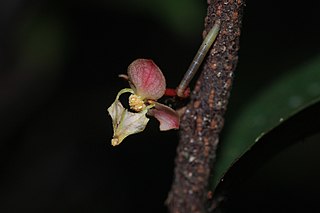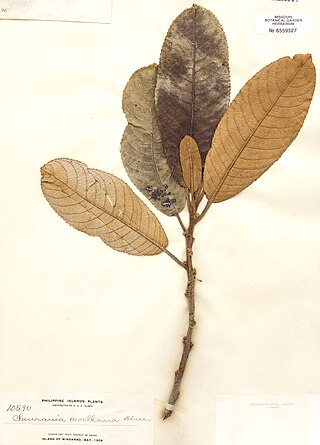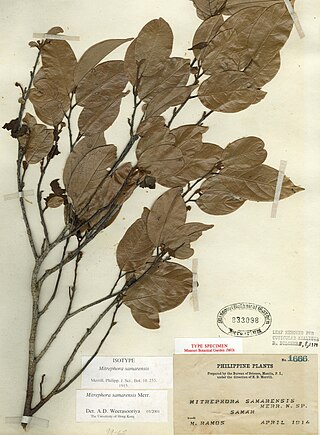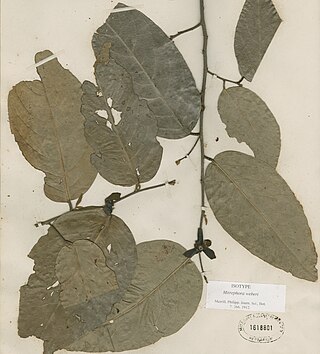
Ulmus rubra, the slippery elm, is a species of elm native to eastern North America. Other common names include red elm, gray elm, soft elm, moose elm, and Indian elm.

Mitrephora is a genus of flowering plants in the family Annonaceae, that are native to an area that extends from China in the north to Queensland. Plants in the genus Mitrephora are also found in southern India and Southeast Asia.
Mitrephora fragrans is a species of plant in the family Annonaceae. It is native to Borneo and The Philippines. Elmer Drew Merrill, the American botanist who first formally described the species, named it after its large, fragrant flowers.
Orophea submaculata is a species of plant in the Annonaceae family. It is endemic to the Philippines. It is threatened by habitat loss.

Orophea thomsonii or Thomson's Turret Flower is a species of shrub or small tree in the Annonaceae family. It is native to Kerala and Tamil Nadu in India and endemic to the Western Ghats mountain range.

Whitfordiodendron is a genus of flowering plants in the legume family, of Fabaceae. It belongs to the subfamily Faboideae.

Saurauia avellana is a species of plant in the Actinidiaceae family. It is native to the Philippines. Adolph Daniel Edward Elmer, the American botanist who first formally described the species, named it after the dense covering of hazel-colored downy hair covering the underside of its leaves.
Goniothalamus nitidus is a species of plant in the family Annonaceae. It is native to Borneo. Elmer Drew Merrill, the American botanist who first formally described the species, named it after its shining leaves.
Goniothalamus puncticulifolius is a species of plant in the family Annonaceae. It is native to Borneo and The Philippines. Elmer Drew Merrill, the American botanist who first formally described the species, named it after its minutely spotted leaves.
Mitrephora macrocarpa is a species of plant in the family Annonaceae. It is native to Sulawesi. Friedrich Anton Wilhelm Miquel, the Dutch botanist who first formally described the species using the basionym Orophea macrocarpa, named it after its large fruit.

Mitrephora samarensis is a species of plant in the family Annonaceae. It is native to the Philippines. Elmer Drew Merrill, the American botanist who first formally described the species, named it after Samar, the third largest island in the Philippines, where the sample he examined was collected.

Mitrephora weberi is a species of plant in the family Annonaceae. It is native to The Philippines. Elmer Drew Merrill, an American botanist, first formally described the species and named it after Charles Martin Weber who collected the specimen that Merrill examined.
Mitrephora williamsii is a species of plant in the family Annonaceae. It is native to The Philippines. Charles Budd Robinson, the Canadian botanist who first formally described the species, named it after Robert Statham Williams who collected the specimen that Robinson examined.

Pseuduvaria costata is a species of plant in the family Annonaceae. It is native to New Guinea. Rudolph Scheffer, the Dutch botanist who first formally described the species using the basionym Orophea costata, named it after its prominently ribbed fruit.

Pseuduvaria luzonensis is a species of plant in the family Annonaceae. It is native to The Philippines. Elmer Drew Merrill, the American botanist who first formally described the species using the synonym Orophea luzoniensis, named it after Luzon in the province of Battan, Philippines where the specimen he examined was collected along the Lamao River.
Pseuduvaria macgregorii is a species of plant in the family Annonaceae. It is native to The Philippines. Elmer Drew Merrill, the American botanist who first formally described the species, named it after Richard MacGregor the Australian ornithologist and plant collector who collected the specimen Merrill examined.

Pseuduvaria pamattonis is a species of plant in the family Annonaceae. It is native to Borneo and the Philippines. Friedrich Miquel, the Dutch botanist who first formally described the species using the basionym Orophea pamattonis, named it after a mountain in Borneo called Gunung Pamaton.
Pseuduvaria pulchella is a species of plant in the family Annonaceae. It is native to New Guinea. Ludwig Diels, the botanist who first formally described the species using the basionym Orophea pulchella, chose a specific epithet that means “beautiful little” in Latin, but he did not specify to which aspect of the plant he was referring.
Pseuduvaria silvestris is a species of plant in the family Annonaceae. It is native to New Guinea. Ludwig Diels, the botanist who first formally described the species under the basionym Orophea silvestris, named it after the forested habitat the specimens he examined were found growing in near the Waria River.

Pseuduvaria unguiculata is a species of plant in the family Annonaceae. It is endemic to The Philippines. Adolph Daniel Edward Elmer, the American botanist who first formally described the species, named it after its clawed inner petals.











